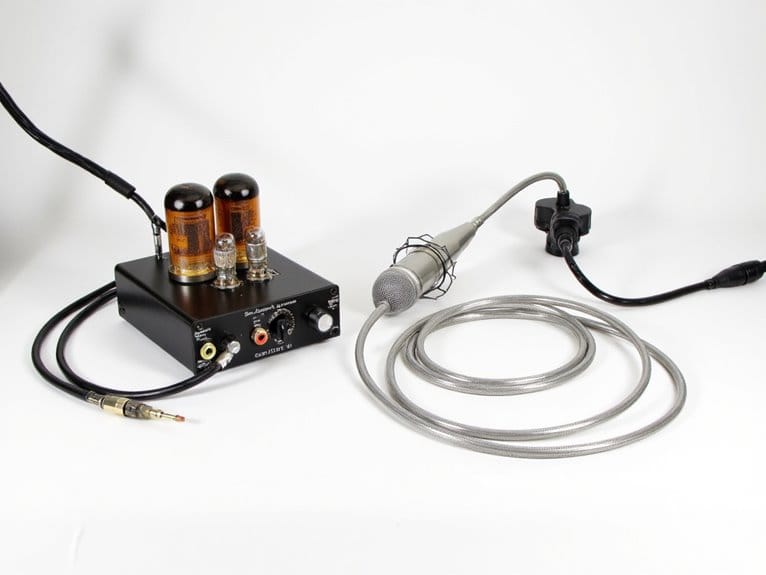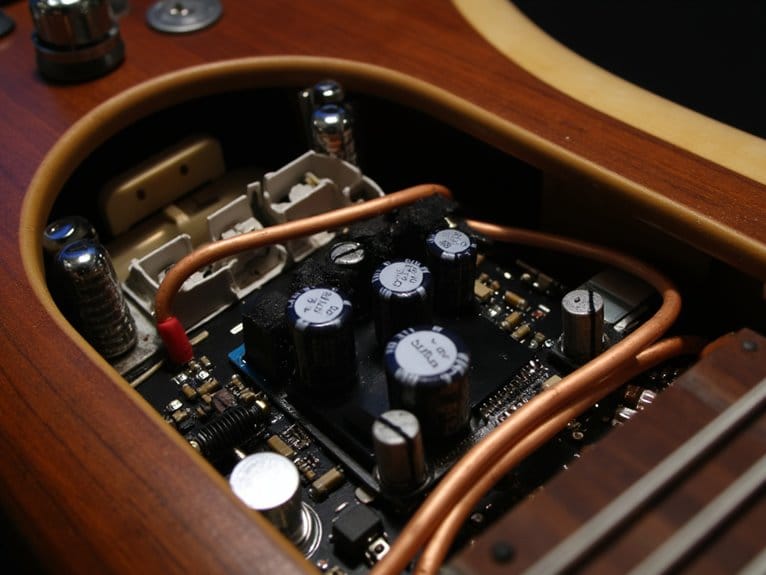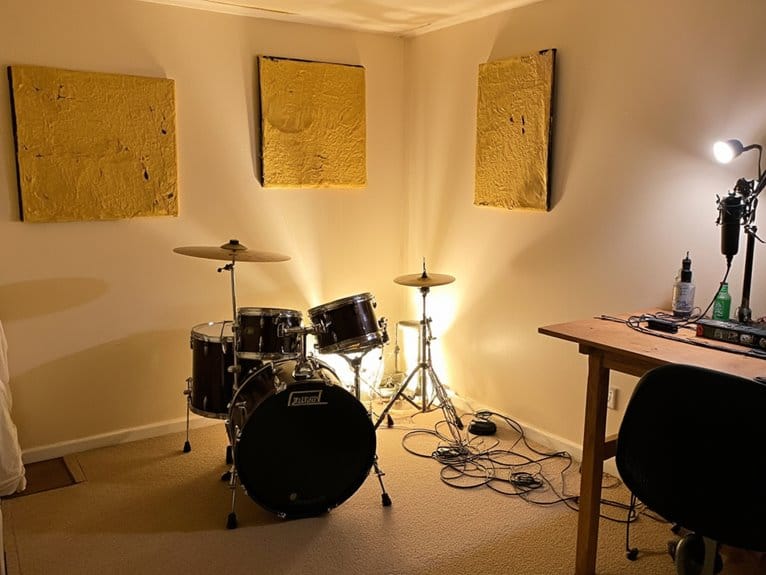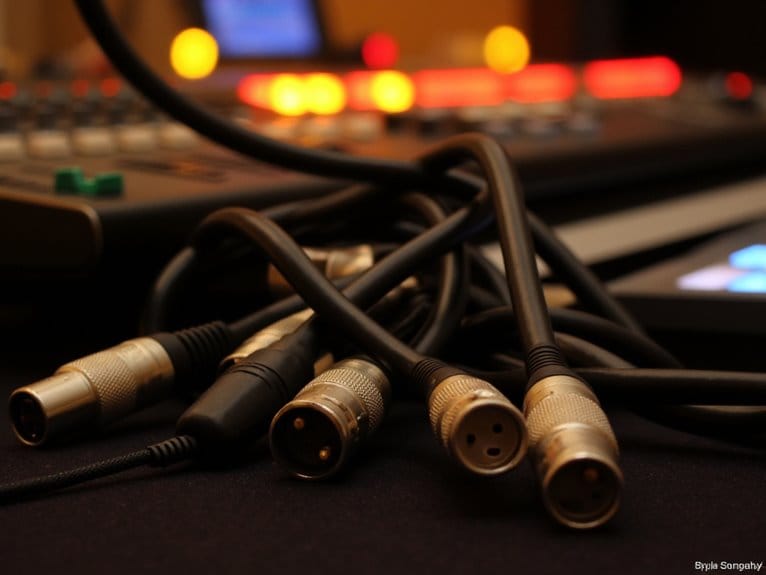Understanding Tube Microphones and Their Sound
You’ll find that tube microphones use vacuum tube amplification to create their signature warm, rich sound through even-order harmonic distortion and natural compression that smooths harsh transients. These condenser mics require about 20 minutes to warm up and an external power supply, but they reward you with enhanced midrange presence and three-dimensional depth that’s particularly stunning on vocals, acoustic guitars, and piano recordings, explaining why studios have treasured them for decades—and there’s considerably more to discover about their technical operation.
We are supported by our audience. When you purchase through links on our site, we may earn an affiliate commission, at no extra cost for you. Learn more.
Notable Insights
- Tube microphones use vacuum tubes to amplify electrical signals from sound waves, creating warm, rich tones with distinctive harmonic coloration.
- These microphones require a 20-minute warm-up period and external power supplies to operate their vacuum tube amplification systems effectively.
- Vacuum tubes introduce even-order harmonics and natural compression, smoothing harsh transients while enriching lower midrange frequencies for fuller sound.
- Technical specs include -30dB to -40dB sensitivity, 120-140dB maximum SPL, signal-to-noise ratios exceeding 80dB, and dynamic range over 120 decibels.
- They excel at recording acoustic guitars, pianos, and strings by capturing natural wood resonance and managing challenging transients with tonal smoothness.
What Are Tube Microphones?
When you’re exploring the world of professional microphones, you’ll inevitably encounter tube microphones, which are fundamentally condenser microphones that incorporate a vacuum tube into their internal circuitry to amplify the audio signal.
Unlike their solid-state counterparts that rely on transistors, these mics use vintage technology to boost low-level audio from the condenser capsule, effectively lowering impedance while raising signal strength for cleaner output.
The vacuum tube functions as an internal head amplifier, preparing your signal before it reaches external preamps, though this design requires a separate power supply to operate the tube components. These microphones typically need a warm-up period of approximately 20 minutes to achieve optimal sound quality and performance.
This audio aesthetics approach delivers the characteristic warm, rich sound that many engineers and artists prefer over the neutral response of modern solid-state microphones. The tube creates preferred harmonic distortion that gives these microphones their distinctive tonal characteristics in professional recording environments.
Essential Components of Tube Microphones
Although tube microphones might seem like simple devices from the outside, I can tell you they’re actually sophisticated pieces of engineering that rely on five essential components working in perfect harmony to capture and amplify your audio. The historical evolution of these microphones has refined each component’s design aesthetics and functionality over decades.
| Component | Primary Function |
|---|---|
| Condenser Capsule | Converts sound waves to electrical signals |
| Vacuum Tube | Amplifies weak signals with harmonic warmth |
| Power Supply Unit | Provides stable electrical energy externally |
The capsule determines your microphone’s sensitivity and frequency response, while the tube adds that distinctive warmth through harmonic distortion. Internal circuitry protects against electrical damage, and the output transformer converts signals for external equipment, contributing to tube microphones’ characteristic tonal coloration. These microphones require a separate power supply to operate effectively, unlike some other microphone types that can draw power through phantom power alone. The microphone cable typically features a 7-pin connector with seven conductors to handle the complex electrical requirements.
The Science Behind Tube Microphone Operation
When you speak into a tube microphone, you’re witnessing a sophisticated chain reaction that transforms your voice into electrical signals through three critical stages.
The capsule first converts sound waves into weak electrical impulses, which then travel to the vacuum tube where they’re amplified and given that characteristic warmth we associate with vintage recordings. Unlike dynamic microphones that rely on electromagnetic induction, tube microphones typically use condenser capsules that require the tube’s amplification to boost their inherently low output signals.
The condenser capsule operates with an electrically conductive diaphragm positioned against a fixed backplate, where diaphragm displacement changes the capacitance and generates voltage proportional to the incoming sound waves.
This signal path architecture, while seemingly straightforward, involves complex interactions between mechanical components and electronic circuits that I’ve spent years studying, and honestly, the physics behind it still fascinates me every time I see it in action.
Capsule Signal Conversion Process
At the heart of every tube microphone lies a sophisticated capsule that functions as an elegant acoustic-to-electrical converter, transforming the invisible dance of sound waves into measurable electrical signals through the precise science of capacitance modulation.
When you speak into a tube microphone, your voice creates pressure variations that cause the thin, metalized diaphragm to vibrate against a fixed backplate. This capsule design forms a variable capacitor, and as the distance between these components changes, so do the capacitance values—typically fluctuating within that critical 10-60 picofarad range.
| Component | Function | Specification |
|---|---|---|
| Diaphragm | Sound capture | Metalized, flexible |
| Backplate | Reference plate | Fixed position |
| Capacitance | Signal generation | 10-60 picofarads |
| Bias voltage | Polarization | ~80 volts |
| Output signal | Conversion result | High impedance, low level |
The 80-volt bias voltage polarizes this capsule, enabling those microscopic capacitance changes to modulate electrical charge and create your audio signal. The precision manufacturing consistency of these capsules directly impacts the final sound quality, which is why established manufacturers maintain strict tolerances throughout the production process. The diaphragm typically features a molecularly thin gold layer that enhances conductivity and provides long-term stability for consistent performance.
Vacuum Tube Amplification
That high-impedance, low-level signal from the capsule’s capacitance changes needs serious amplification before it can travel down microphone cables to your preamp, and this is where the vacuum tube’s remarkable physics takes center stage.
When you heat the cathode, it releases electrons through thermionic emission, creating a controlled flow between cathode and anode that’s modulated by the grid according to your input signal.
This process, with its historical significance dating back to early recording studios, produces that coveted warmth through subtle nonlinearities and harmonic distortion that solid-state circuits can’t quite replicate. The tube circuit specifically adds even harmonics to the signal, which enhances the richness and creates that euphonious character that makes vocals and instruments sound more musical.
While upcoming trends favor digital processing, the tube’s 20-minute warm-up time and external power requirements remain worthwhile trade-offs for achieving that unmistakably smooth, musical character. Like condenser microphones, tube microphones require phantom power to operate their internal electronics and achieve optimal performance.
Signal Path Architecture
While tube amplification provides that distinctive sonic character, understanding how these microphones actually process your voice requires tracing the complete signal path from the moment sound waves hit the capsule to when amplified audio exits through the XLR connector.
The signal path optimization in tube microphones follows a carefully engineered sequence that I’ve found creates their legendary sound quality:
- Your voice creates air pressure variations that move the condenser capsule’s diaphragm against its backplate.
- This movement generates tiny electrical signals through capacitance changes, typically in the microvolt range.
- The vacuum tube’s grid receives these signals and modulates electron flow between cathode and anode.
- Miller capacitance creates controlled feedback that shapes frequency response and tonal character.
- Impedance matching circuits convert high-impedance capsule output to robust, low-impedance signals for transmission.
This architecture explains why tube microphones sound fundamentally different from their solid-state counterparts.
Signal Path and Power Requirements
Understanding the signal path in tube microphones requires tracing the journey from that initial capsule vibration all the way to your recording device, and I’ll be honest—it’s more complex than the simple plug-and-play setup you get with most modern mics.
Your signal travels through several critical stages that demand precise engineering:
- Capsule types produce those tiny electrical signals that barely register as whispers in the circuit.
- Head amplifier stage uses the tube’s grid to modulate electron flow and boost signal strength.
- Impedance matching transformer converts high-impedance tube output to standard 200-ohm levels.
- External power supply unit feeds necessary DC voltages through specialized multi-conductor cables.
- Output stage isolates your clean signal from internal DC voltages before reaching your preamp.
This complex routing requires dedicated external power, unlike condenser mics that run on phantom power alone.
Sound Characteristics and Tonal Qualities

All that complex circuitry I just described serves one fundamental purpose: creating the distinctive sonic signature that’s made tube microphones legendary in recording studios for over seventy years.
When you’re recording through a tube mic, you’re not getting a sterile, clinical reproduction of your voice or instrument. Instead, the vacuum tube adds even-order harmonics that create what engineers call tone coloration, enriching your sound with warm harmonics that make everything feel fuller and more musical.
This natural compression smooths out harsh transients while emphasizing lower midrange frequencies, giving you that coveted vintage warmth. The result is a sound that’s less flat than solid-state mics but infinitely more characterful, which is why these microphones command premium prices in today’s market.
Tube vs. Solid-State Microphone Comparison
When choosing between tube and solid-state microphones, you’re fundamentally deciding between two fundamentally different amplification philosophies that shape how your recordings sound from the moment signal leaves the capsule.
Tube microphone advantages become apparent when you consider their distinctive sonic characteristics:
- Warm-up ritual – That few-minute wait before recording creates anticipation, like coffee brewing
- Harmonic richness – Natural compression and distortion add musical character your ears crave
- Glass vulnerability – Fragile tubes demand careful handling, like precious instruments
- Heat generation – Internal warmth reminds you of vintage gear’s analog heritage
- Maintenance dance – Periodic tube replacement keeps you connected to your equipment
While solid state microphone drawbacks include clinical precision that sometimes lacks soul, I’ve found their immediate readiness and reliability often outweigh tube romanticism for demanding production schedules.
On a final note
You’ve explored the intricate world of tube microphones, from their vacuum tube amplification processes to their distinctive harmonic coloration that’s shaped countless recordings. While they’ll require more maintenance than solid-state alternatives, and you’ll need to budget for tube replacements, the sonic character they provide remains unmatched for capturing vocals and acoustic instruments. Whether you’re tracking in your home studio or performing live, understanding these fundamentals helps you make informed decisions about incorporating tube microphones into your setup.






